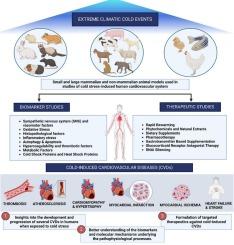“揭示气候寒冷事件对动物模型心血管健康的影响”
IF 8
1区 环境科学与生态学
Q1 ENVIRONMENTAL SCIENCES
引用次数: 0
摘要
气候变化越来越多地导致极端天气事件,导致全球气温剧烈波动。在总体气温上升的同时,许多地区正在经历严重的寒流,威胁着人类的健康,特别是对老年人和已有疾病的人等弱势群体。暴露于冷应激会引发显著的生理和生化破坏。由于心血管疾病是全球发病率和死亡率的主要原因之一,寒冷暴露加剧了这些疾病,凸显了重大的公共卫生挑战。冷诱导cvd的复杂病理生理过程需要在器官系统水平上仔细分析,这使得动物模型成为在受控环境中复制人体生理和分子反应的理想工具。然而,冷暴露和心血管功能障碍之间的详细机制仍然不完全清楚,特别是在动物模型的背景下。因此,本综述旨在从传统的啮齿动物模型到非常规的反刍动物、肉鸡、犬科动物和灵长类动物模型进行分析,以了解冷应激诱导的cvd,并广泛阐述潜在的分子机制和途径,如氧化应激、炎症、血管舒缩功能障碍和细胞凋亡,以及冷休克蛋白(CSPs)等的新作用。我们还深入探讨了在冷应激条件下各种潜在的治疗方法和预防措施。总之,这篇综述首次全面探讨了冷应激引起的心血管并发症及其潜在机制,特别是利用动物模型。此外,它为通过转化研究推进更有效和更有针对性的治疗提供了基础。本文章由计算机程序翻译,如有差异,请以英文原文为准。

“Unveiling the impacts of climatic cold events on the cardiovascular health in animal models”
Climate change is increasingly driving extreme weather events, leading to drastic temperature fluctuations worldwide. While overall temperatures rise, many regions are simultaneously experiencing severe cold spells that threaten the health of human populations, especially to vulnerable populations including the elderly and those with pre-existing conditions. Exposure to cold stress triggers significant physiological and biochemical disruptions. As cardiovascular diseases (CVDs) rank among the leading causes of global morbidity and mortality, the exacerbation of these conditions by cold exposure underscores critical public health challenges.
The complex pathophysiological processes in cold-induced CVDs require careful analysis at an organ-system level, making animal models an ideal tool for replicating human physiological and molecular responses in a controlled environment. However, a detailed mechanism linking cold exposure and cardiovascular dysfunction remains incompletely understood, particularly in the context of animal models. Therefore, this comprehensive review aims to address and analyze from traditional rodent models to less conventional ruminants, broilers, canines, and primate animal models to understand cold stress-induced CVDs, with an extensive account of the potential molecular mechanisms and pathways such as oxidative stress, inflammation, vasomotor dysfunction, and apoptosis, along with emerging roles of cold shock proteins (CSPs), etc. We also delve into various potential therapeutic approaches and preventive measures in cold stress conditions. In conclusion, this review is the first to comprehensively address the underexplored cardiovascular complications arising from cold stress and their underlying mechanisms, particularly using animal models. Furthermore, it provides a foundation for advancing the development of more effective and targeted therapies through translational research.
求助全文
通过发布文献求助,成功后即可免费获取论文全文。
去求助
来源期刊

Science of the Total Environment
环境科学-环境科学
CiteScore
17.60
自引率
10.20%
发文量
8726
审稿时长
2.4 months
期刊介绍:
The Science of the Total Environment is an international journal dedicated to scientific research on the environment and its interaction with humanity. It covers a wide range of disciplines and seeks to publish innovative, hypothesis-driven, and impactful research that explores the entire environment, including the atmosphere, lithosphere, hydrosphere, biosphere, and anthroposphere.
The journal's updated Aims & Scope emphasizes the importance of interdisciplinary environmental research with broad impact. Priority is given to studies that advance fundamental understanding and explore the interconnectedness of multiple environmental spheres. Field studies are preferred, while laboratory experiments must demonstrate significant methodological advancements or mechanistic insights with direct relevance to the environment.
 求助内容:
求助内容: 应助结果提醒方式:
应助结果提醒方式:


